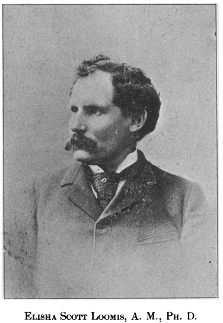 Elisha Scott Loomis was born in a log cabin near Wadsworth, Ohio, in
Medina County on September 18, 1852. He was the eldest of eight
children of Charles W. and Sarah (Oberholtzer) Loomis. His father died
when Elisha was twelve and, the following summer, the young Loomis hired
out to a farmer for six months, at three dollars per month, to help
support his family. He worked at various farms for seven summers, and
his wages eventually reached $16 per month. Meanwhile he was attending
country district schools in the winters. Once he walked seven miles to
a nearby town to purchase a copy of Ray¼s Elementary Algebra, which he
proceeded to master on his own since the district school teacher knew
nothing about algebra.
Elisha Scott Loomis was born in a log cabin near Wadsworth, Ohio, in
Medina County on September 18, 1852. He was the eldest of eight
children of Charles W. and Sarah (Oberholtzer) Loomis. His father died
when Elisha was twelve and, the following summer, the young Loomis hired
out to a farmer for six months, at three dollars per month, to help
support his family. He worked at various farms for seven summers, and
his wages eventually reached $16 per month. Meanwhile he was attending
country district schools in the winters. Once he walked seven miles to
a nearby town to purchase a copy of Ray¼s Elementary Algebra, which he
proceeded to master on his own since the district school teacher knew
nothing about algebra.
In the summer of 1873 Loomis taught school for 54 days and earned $50. By this time he had accumulated savings of $250 and, in September, he entered Baldwin University (now Baldwin-Wallace College) in Berea, Ohio. There he came under the influence of Aaron Schuyler, whom he would later succeed as professor of mathematics.
Loomis graduated from Baldwin University on June 17, 1880, and a week later married Letitia Shire, had been teaching school near Loudonville, Ohio. He was principal of the Burbank (Ohio) Academy for one year and then served four years as the principal of Richfield Central High School in Summit County. He was elected to the chair of mathematics at his alma mater in August, 1885.
While he was living in Berea, Loomis began to study civil engineering and became the village engineer. He also served a three-year term as president of the Berea board of education. He continued to study while he taught, and this led to an A. M. degree from Wooster (Ohio) University in 1886 and a Ph.D. in metaphysics and social science from that same institution in 1888. The subject of his doctoral thesis was "Theism the Result of Completed Investigation."
In 1895 Professor Loomis left Baldwin University to become head of the mathematics department at Cleveland West High School, where he remained until his retirement in 1923. In 1900 he earned the LL.B. degree from the Cleveland Law School and was admitted to the Ohio state bar. He served a 3-year term as president of the High School Teachers¼ Mathematics Club of Cleveland, and he was active in the Masonic lodge.
Loomis wrote several books on geometry and the teaching of mathematics in high schools, including Original Investigation; or How to Attack an Exercise in Geometry, published in 1901. He is probably best known for his work, The Pythagorean Proposition, a compendium of more than 250 proofs of that famous theorem. The manuscript was prepared in 1907 and published in 1927. A second edition appeared in 1940, and this was reprinted by the National Council of Teachers of Mathematics in 1968 as part of its "Classics in Mathematics Education" series.
By his own count, Loomis published "a hundred or more articles on educational, pedagogical mathematical, and genealogical subjects." This includes numerous problems and solutions submitted to The American Mathematical Monthly. Loomis also wrote the Life and Appreciation of Dr. Aaron Schuyler, a loving tribute to his mentor at Baldwin University.
Elisha S. Loomis was a cousin of the mathematician, Elias Loomis and a descendant of Joseph Loomis, who had come to this country from England in 1630. In 1908 Elisha Loomis completed an 859-page revision of the genealogy, Descendants of Joseph Loomis in America, and His Antecedents in the Old World, which Elias Loomis had published in 1875. He also published a 412-page Genealogy of Jacob Oberholtzer.
Loomis was known for living an orderly life, and this extended to writing his own obituary in 1934, which he left in a letter addressed "For the Berea Enterprise immediately following my death." He died on December 11, 1940, and the obituary was published as he had written it except for the date of his death and the addresses of some of his survivors.
In his obituary, Loomis claimed to have "plowed habit-formation grooves in the plastic brains of over 4000 boys and girls and young men and women." Concerning his own success in life he wrote, "Of all honors conferred upon him he prized the title of 'Teacher' more than any other, either educational, social, or secret."